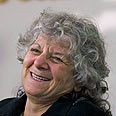
Prof. Yonath promotes regional scientific cooperation in Jordan
Israeli Nobel Prize laureate arrives in Petra to attend convention on regional particle accelerator, project aimed at promoting Mideast scientific cooperation
With less than three weeks before she is called to the stage in Stockholm to officially receive the 2009 Nobel Prize for chemistry, Prof. Ada Yonath from the Weizmann Institute of Science arrived in Petra, Jordan. Yonath is visiting Israel's Muslim neighbor to promote regional science projects and visit the recently inaugurated particle accelerator – Sesame.
Seventy-year-old Yonath will accept the prestigious award on December 10 in Stockholm's Municipal hall.
Since she was announced as 2009's chemistry Nobel Prize recipient in October, Yonath has been mainly busy turning down various offers for interviews, receptions and functions. The offer to attend a Sesame convention in Jordan she could not refuse. There, she was welcomed by colleagues from Egypt, Pakistan, Tunisia, Turkey, the Palestinian Authority as well as from top science institutes in Iran.
The Sesame project is aimed at constructing the Middle East's first major international research centre as a cooperative venture by the scientists and governments of the region. "I'm here to honor my friends who have been leading this project and to try and secure its chances of survival," Yonath said and noted the lack of funds for the venture.
"The regional governments don't provide enough (funding). We need a big contribution from one of the region's more well-established governments."
The project began in 1997 when German elements in Berlin decided to dismantle the Bessy particle accelerator. A group of scientists headed by Professor Herman Winick from Stanford University managed to convince the German government, UNESCO and the US administration to save the accelerator and transfer it to a region which lacked such an installation. Winick, a Brookline-based Jew offered to transfer the accelerator to Israel.
Yonath admits was against the idea at first as was the former Weizmann institute head. "Our condition was that the accelerator be significantly improved and adjusted to much higher energy acceleration rates," the scientist said. It was eventually decided to transfer the device to Jordan, allowing scientists from the Middle East easier access.
"It was a pretty major undertaking bringing an accelerator of that level to the region," Yonath said and related how one of her friends, an ad man, proposed calling the installation the "peace accelerator. I thought it was a great name, but it was ultimately decided to call it Sesame."
Sesame became a center of scientific cooperation between researches from the entire region. Jordanian King Abdullah said at the inauguration ceremony, "This place was meant to promote peace and understanding on the basis of scientific collaboration."
Word in the convention was that the tensions arose not opposite Israel, but between Egypt and Iran, while Jordan saw itself as a mediator of such conflicts.
Construction of the accelerator began in 2003, north of Amman, in a specially allotted area. It was inaugurated a year ago and its first x ray was produced three months ago. A Sesame management statement issued in July 2009 read, "On this day the first ray emerged from the particle accelerator in Jordan, a ray of light of peace and regional cooperation for the benefit of all residents of the region and science."
A Sesame scientific committee was been created and its members travel the region to discuss science, experiments and peace. Such was the nature of the convention in Petra which was attended by over 200 participants.
Enthusiastic Iranian reception
During her lecture, Yonath related her professional experiences, including her achievement in discovering the functions of the ribosome, for which she was awarded the Nobel Prize. There was no mention of politics. The lecture, which was scheduled to last 40 minutes extended to nearly two hours.
After her speech Yonath was greeted by the entire Iranian delegation. The young Iranian female scientists were eager to hear more from her.
"You are our inspiration, not just as a scientist but also as a woman," Asda Shehaswar from the Iranian high technological institute. "We know how difficult it was for you and what you had to go through. This whole gathering was worth it if only to hear your lecture," she said and proceeded to hug the overwhelmed Yonath.
The young Iranian researcher later said she was aware of the politics of science and its possible destructive nature, but stressed that for her it was a bridge. "Science allows a connection of knowledge, a means for better medicine, a better world. I want to be a bridge. My heart beats in the same language as my fellow scientists."










